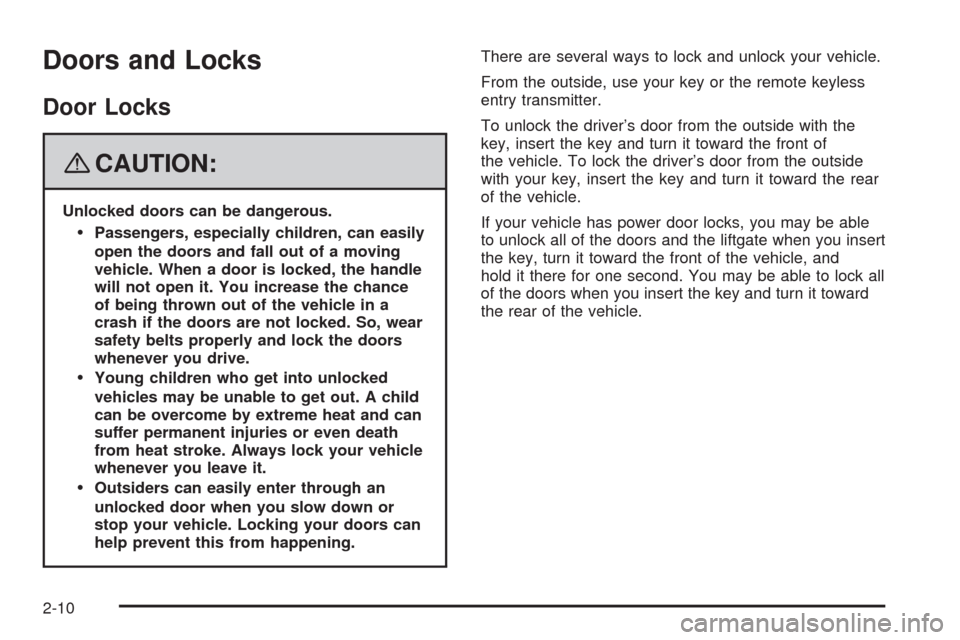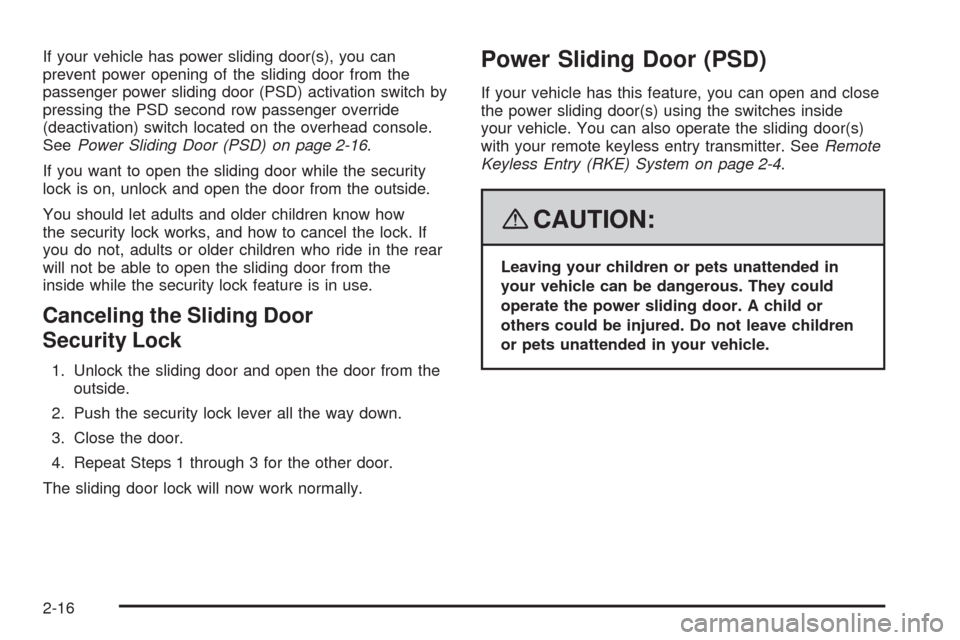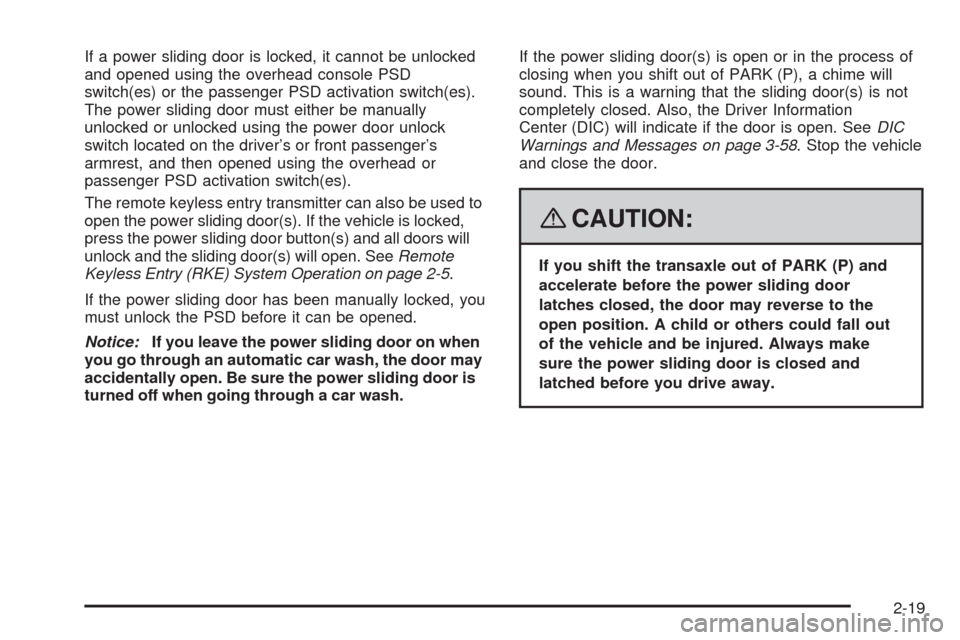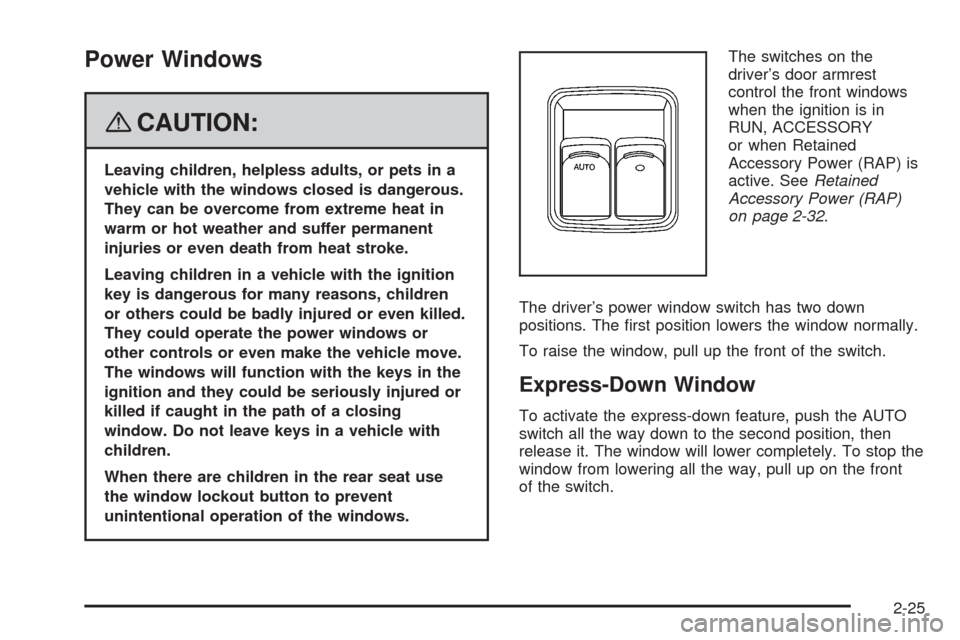2008 CHEVROLET UPLANDER child lock
[x] Cancel search: child lockPage 99 of 476

Keys
{CAUTION:
Leaving children in a vehicle with the ignition
key is dangerous for many reasons, children
or others could be badly injured or even killed.
They could operate the power windows or
other controls or even make the vehicle move.
The windows will function with the keys in the
ignition and they could be seriously injured or
killed if caught in the path of a closing
window. Do not leave the keys in a vehicle
with children.
The key can be used for the ignition and the driver’s
door lock.
Your vehicle has the PASS-Key
®III vehicle theft
system. The key has a transponder in the key head that
matches a decoder in the vehicle’s steering column.
If a replacement key or any additional key is needed,
you must purchase this key from your dealer/retailer.
The key will have PK3 stamped on it. Keep the bar code
tag that came with the original keys. Give this tag to
your dealer/retailer if you need a new key made.
2-3
Page 106 of 476

Doors and Locks
Door Locks
{CAUTION:
Unlocked doors can be dangerous.
Passengers, especially children, can easily
open the doors and fall out of a moving
vehicle. When a door is locked, the handle
will not open it. You increase the chance
of being thrown out of the vehicle in a
crash if the doors are not locked. So, wear
safety belts properly and lock the doors
whenever you drive.
Young children who get into unlocked
vehicles may be unable to get out. A child
can be overcome by extreme heat and can
suffer permanent injuries or even death
from heat stroke. Always lock your vehicle
whenever you leave it.
Outsiders can easily enter through an
unlocked door when you slow down or
stop your vehicle. Locking your doors can
help prevent this from happening.There are several ways to lock and unlock your vehicle.
From the outside, use your key or the remote keyless
entry transmitter.
To unlock the driver’s door from the outside with the
key, insert the key and turn it toward the front of
the vehicle. To lock the driver’s door from the outside
with your key, insert the key and turn it toward the rear
of the vehicle.
If your vehicle has power door locks, you may be able
to unlock all of the doors and the liftgate when you insert
the key, turn it toward the front of the vehicle, and
hold it there for one second. You may be able to lock all
of the doors when you insert the key and turn it toward
the rear of the vehicle.
2-10
Page 111 of 476

Lock either sliding door from inside the vehicle by
moving the manual lever down. Unlock it by moving the
lever up.
With the power door locks, the sliding door lock has a
delay feature. SeeDelayed Locking on page 2-12
andDIC Vehicle Personalization (Uplevel Only) on
page 3-76.
Sliding Door Security Lock
Your vehicle is equipped with sliding door security locks
that helps prevent young children or other passengers
from opening the sliding door(s) using the inside
door handle. To use one of these locks, do the following:
1. Open the sliding door.
2. On the inside of the
sliding door(s), on the
front edge of the
door will be a lock.
Push the lever
up to engage the lock.
3. Close the door.
4. Repeat Steps 1 through 3 for the other door.
2-15
Page 112 of 476

If your vehicle has power sliding door(s), you can
prevent power opening of the sliding door from the
passenger power sliding door (PSD) activation switch by
pressing the PSD second row passenger override
(deactivation) switch located on the overhead console.
SeePower Sliding Door (PSD) on page 2-16.
If you want to open the sliding door while the security
lock is on, unlock and open the door from the outside.
You should let adults and older children know how
the security lock works, and how to cancel the lock. If
you do not, adults or older children who ride in the rear
will not be able to open the sliding door from the
inside while the security lock feature is in use.
Canceling the Sliding Door
Security Lock
1. Unlock the sliding door and open the door from the
outside.
2. Push the security lock lever all the way down.
3. Close the door.
4. Repeat Steps 1 through 3 for the other door.
The sliding door lock will now work normally.
Power Sliding Door (PSD)
If your vehicle has this feature, you can open and close
the power sliding door(s) using the switches inside
your vehicle. You can also operate the sliding door(s)
with your remote keyless entry transmitter. SeeRemote
Keyless Entry (RKE) System on page 2-4.
{CAUTION:
Leaving your children or pets unattended in
your vehicle can be dangerous. They could
operate the power sliding door. A child or
others could be injured. Do not leave children
or pets unattended in your vehicle.
2-16
Page 115 of 476

If a power sliding door is locked, it cannot be unlocked
and opened using the overhead console PSD
switch(es) or the passenger PSD activation switch(es).
The power sliding door must either be manually
unlocked or unlocked using the power door unlock
switch located on the driver’s or front passenger’s
armrest, and then opened using the overhead or
passenger PSD activation switch(es).
The remote keyless entry transmitter can also be used to
open the power sliding door(s). If the vehicle is locked,
press the power sliding door button(s) and all doors will
unlock and the sliding door(s) will open. SeeRemote
Keyless Entry (RKE) System Operation on page 2-5.
If the power sliding door has been manually locked, you
must unlock the PSD before it can be opened.
Notice:If you leave the power sliding door on when
you go through an automatic car wash, the door may
accidentally open. Be sure the power sliding door is
turned off when going through a car wash.If the power sliding door(s) is open or in the process of
closing when you shift out of PARK (P), a chime will
sound. This is a warning that the sliding door(s) is not
completely closed. Also, the Driver Information
Center (DIC) will indicate if the door is open. SeeDIC
Warnings and Messages on page 3-58. Stop the vehicle
and close the door.
{CAUTION:
If you shift the transaxle out of PARK (P) and
accelerate before the power sliding door
latches closed, the door may reverse to the
open position. A child or others could fall out
of the vehicle and be injured. Always make
sure the power sliding door is closed and
latched before you drive away.
2-19
Page 121 of 476

Power Windows
{CAUTION:
Leaving children, helpless adults, or pets in a
vehicle with the windows closed is dangerous.
They can be overcome from extreme heat in
warm or hot weather and suffer permanent
injuries or even death from heat stroke.
Leaving children in a vehicle with the ignition
key is dangerous for many reasons, children
or others could be badly injured or even killed.
They could operate the power windows or
other controls or even make the vehicle move.
The windows will function with the keys in the
ignition and they could be seriously injured or
killed if caught in the path of a closing
window. Do not leave keys in a vehicle with
children.
When there are children in the rear seat use
the window lockout button to prevent
unintentional operation of the windows.The switches on the
driver’s door armrest
control the front windows
when the ignition is in
RUN, ACCESSORY
or when Retained
Accessory Power (RAP) is
active. SeeRetained
Accessory Power (RAP)
on page 2-32.
The driver’s power window switch has two down
positions. The �rst position lowers the window normally.
To raise the window, pull up the front of the switch.
Express-Down Window
To activate the express-down feature, push the AUTO
switch all the way down to the second position, then
release it. The window will lower completely. To stop the
window from lowering all the way, pull up on the front
of the switch.
2-25
Page 322 of 476

Tire Inspection and Rotation...........................5-62
When It Is Time for New Tires.......................5-64
Buying New Tires.........................................5-65
Different Size Tires and Wheels......................5-66
Uniform Tire Quality Grading..........................5-67
Wheel Alignment and Tire Balance..................5-68
Wheel Replacement......................................5-68
Tire Chains..................................................5-70
Accessory In�ator.........................................5-70
If a Tire Goes Flat........................................5-72
Changing a Flat Tire.....................................5-73
Removing the Spare Tire and Tools................5-74
Removing the Flat Tire and Installing the
Spare Tire................................................5-76
Secondary Latch System...............................5-83
Storing a Flat or Spare Tire and Tools............5-86
Compact Spare Tire......................................5-89
Appearance Care............................................5-90
Interior Cleaning...........................................5-90
Fabric/Carpet...............................................5-91
Leather.......................................................5-92
Instrument Panel, Vinyl, and Other
Plastic Surfaces........................................5-92
Child Restraint Pad.......................................5-92
Care of Safety Belts and Built-in
Child Restraint Harness..............................5-93Weatherstrips...............................................5-93
Washing Your Vehicle...................................5-93
Cleaning Exterior Lamps/Lenses.....................5-94
Finish Care..................................................5-94
Windshield, Backglass, and Wiper Blades.........5-95
Aluminum Wheels.........................................5-95
Tires...........................................................5-96
Sheet Metal Damage.....................................5-96
Finish Damage.............................................5-96
Underbody Maintenance...............................
.5-96
Chemical Paint Spotting.................................5-96
Vehicle Care/Appearance Materials..................5-97
Vehicle Identi�cation......................................5-98
Vehicle Identi�cation Number (VIN).................5-98
Service Parts Identi�cation Label.....................5-98
Electrical System............................................5-99
Add-On Electrical Equipment..........................5-99
Headlamp Wiring..........................................5-99
Windshield Wiper Fuses................................5-99
Power Windows and Other Power Options.......5-99
Fuses and Circuit Breakers..........................5-100
Instrument Panel Fuse Block........................5-100
Underhood Fuse Block................................5-102
Capacities and Speci�cations........................5-105
Section 5 Service and Appearance Care
5-2
Page 433 of 476

Maintenance Footnotes
#Lubricate the suspension, steering linkage, and the
underbody contact points and linkage.
(a)Visually inspect brake lines and hoses for proper
hook-up, binding, leaks, cracks, chafing, etc. Inspect
disc brake pads for wear and rotors for surface
condition. Inspect other brake parts, including calipers,
parking brake, etc. Check parking brake adjustment.
(b)Visually inspect front and rear suspension and
steering system for damaged, loose, or missing parts,
signs of wear, or lack of lubrication. Inspect power
steering lines and hoses for proper hook-up, binding,
leaks, cracks, chafing, etc.
(c)Visually inspect hoses and have them replaced if they
are cracked, swollen, or deteriorated. Inspect all pipes,
fittings and clamps; replace with genuine parts as
needed. To help ensure proper operation, a pressure
test of the cooling system and pressure cap and cleaning
the outside of the radiator and air conditioning condenser
is recommended at least once a year.
(d)Inspect wiper blades for wear, cracking, or
contamination. Clean the windshield and wiper blades,
if contaminated. Replace wiper blades that are wornor damaged. See Windshield Wiper Blade Replacement
on page 5-47 and Windshield, Backglass, and Wiper
Blades on page 5-95 for more information.
(e)Make sure the safety belt reminder light and safety
belt assemblies are working properly. If your vehicle
has a built-in child restraint, make sure the harness
straps, latch plates, buckle, clip, child head restraint, and
anchorages are working properly. Look for any other
loose or damaged safety belt system parts. If you
see anything that might keep a safety belt system from
doing its job, have it repaired. Have any torn or
frayed safety belts replaced. Also see Checking the
Restraint Systems on page 1-91.
(f)Lubricate all key lock cylinders, hood latch
assemblies, secondary latches, pivots, spring anchor
and release pawl, hood and door hinges, rear folding
seats, liftgate hinges, fuel door hinge, power sliding
door cable, and sliding door track(s). More frequent
lubrication may be required when exposed to a corrosive
environment. Applying silicone grease on weatherstrips
with a clean cloth will make them last longer, seal
better, and not stick or squeak.
(g)If you drive regularly under dusty conditions, inspect
the filter at each engine oil change.
6-7